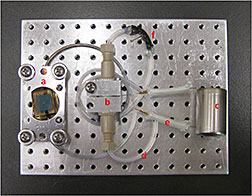- Number 392 |
- July 8, 2013
New imaging tool directly measures liquid surfaces

The schematic of a vacuum compatible
aqueous SIMS device. Insert shows the
secondary H- and Si- ion images of this
aperture.
Designed and fabricated at DOE’s Pacific Northwest National Laboratory, a one-of-a-kind liquid probe continuously pumps liquid samples through a gold-coated microfluidic chamber, presenting these volatile liquids to scientific instruments for thorough analysis. The device’s extremely narrow channel provides high linear velocity at the detection window and helps overcome the liquids' tendency to vaporize. Instruments access the liquid via an open viewing port. Tests with electron microscopes and time-of-flight secondary ion mass spectrometers prove the device can continuously present complex liquids for up to 8 hours.
"Our flow cell opens a window to observe interactions between liquid/solids and liquid surfaces, which are relevant to liquid/solid heterogeneous catalysis and energy storage techniques," said Dr. Xiao-Ying Yu at PNNL, who worked on the study.
This new tool allows scientists to obtain precise data on interfacial reactions, the interactions that occur between a liquid and solid or two liquids. These interactions are vital for quick, affordable methods of storing electricity from wind turbines and effectively trapping and removing industrial solvents from soil.
"Great discoveries often require great tools," said Dr. Louis Terminello, who leads chemical imaging work at PNNL. "The discoveries needed to solve today's problems aren't something that you're going to get by eyeballing a sample and analyzing a spreadsheet."
This research was funded by DOE’s Chemical Sciences, Geosciences, and Biosciences Division, the Office of Biological and Environmental Research, the Use at Facility Funds at PNNL, and the Chemical Imaging Initiative, funded by PNNL's Laboratory Directed Research and Development Office.[Kristin Manke, 509.372.6011,
kristin.manke@pnnl.gov]
